Establishment of a diabetic mouse model with progressive diabetic nephropathy
- PMID: 16049320
- PMCID: PMC1603579
- DOI: 10.1016/s0002-9440(10)62978-1
Establishment of a diabetic mouse model with progressive diabetic nephropathy
Abstract
Although diabetic animal models exist, no single animal model develops renal changes identical to those seen in humans. Here we show that transgenic mice that overexpress inducible cAMP early repressor (ICER Igamma) in pancreatic beta cells are a good model to study the pathogenesis of diabetic nephropathy. Although ICER Igamma transgenic mice exhibit extremely high blood glucose levels throughout their lives, they survive long enough to develop diabetic nephropathy. Using this model we followed the progress of diabetic renal changes compared to those seen in humans. By 8 weeks of age, the glomerular filtration rate (GFR) was already increased, and glomerular hypertrophy was prominent. At 20 weeks, GFR reached its peak, and urine albumin excretion rate was elevated. Finally, at 40 weeks, diffuse glomerular sclerotic lesions were prominently accompanied by increased expression of collagen type IV and laminin and reduced expression of matrix metalloproteinase-2. Nodular lesions were absent, but glomerular basement membrane thickening was prominent. At this point, GFR declined and urinary albumin excretion rate increased, causing a nephrotic state with lower serum albumin and higher serum total cholesterol. Thus, similar to human diabetic nephropathy, ICER Igamma transgenic mice exhibit a stable and progressive phenotype of diabetic kidney disease due solely to chronic hyperglycemia without other modulating factors.
Figures
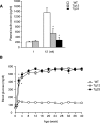
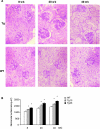
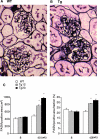
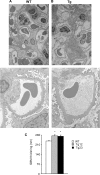
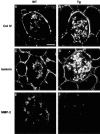
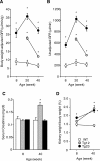

Similar articles
-
A model for diabetic nephropathy: advantages of the inducible cAMP early repressor transgenic mouse over the streptozotocin-induced diabetic mouse.J Cell Physiol. 2008 May;215(2):383-91. doi: 10.1002/jcp.21316. J Cell Physiol. 2008. PMID: 18270980
-
Diabetic kidney lesions of GIPRdn transgenic mice: podocyte hypertrophy and thickening of the GBM precede glomerular hypertrophy and glomerulosclerosis.Am J Physiol Renal Physiol. 2009 Apr;296(4):F819-29. doi: 10.1152/ajprenal.90665.2008. Epub 2009 Feb 11. Am J Physiol Renal Physiol. 2009. PMID: 19211686
-
Characterization of diabetic nephropathy in a transgenic model of hypoinsulinemic diabetes.Am J Physiol Renal Physiol. 2006 Dec;291(6):F1315-22. doi: 10.1152/ajprenal.00379.2005. Epub 2006 May 16. Am J Physiol Renal Physiol. 2006. PMID: 16705146
-
The stages in diabetic renal disease. With emphasis on the stage of incipient diabetic nephropathy.Diabetes. 1983 May;32 Suppl 2:64-78. doi: 10.2337/diab.32.2.s64. Diabetes. 1983. PMID: 6400670 Review.
-
Glomerular hemodynamic and structural alterations in experimental diabetes mellitus.FASEB J. 1988 May;2(8):2339-47. doi: 10.1096/fasebj.2.8.3282959. FASEB J. 1988. PMID: 3282959 Review.
Cited by
-
Differences in long-term effects of standard rodent diets on blood glucose and body weight of offspring.Diabetol Int. 2022 Mar 24;13(4):615-623. doi: 10.1007/s13340-022-00578-x. eCollection 2022 Oct. Diabetol Int. 2022. PMID: 36117929 Free PMC article.
-
Serum arylhydrocarbon receptor transactivating activity is elevated in type 2 diabetic patients with diabetic nephropathy.J Diabetes Investig. 2013 Sep 13;4(5):483-91. doi: 10.1111/jdi.12081. Epub 2013 Apr 22. J Diabetes Investig. 2013. PMID: 24843699 Free PMC article.
-
Matrix metalloproteinases: their potential role in the pathogenesis of diabetic nephropathy.Endocrine. 2009 Feb;35(1):1-10. doi: 10.1007/s12020-008-9114-6. Epub 2008 Oct 30. Endocrine. 2009. PMID: 18972226 Free PMC article. Review.
-
Effect of the Direct Renin Inhibitor Aliskiren on Urinary Albumin Excretion in Spontaneous Type 2 Diabetic KK-A (y) Mouse.Int J Nephrol. 2013;2013:519130. doi: 10.1155/2013/519130. Epub 2013 Jun 2. Int J Nephrol. 2013. PMID: 23819050 Free PMC article.
-
Adjusting the 17β-Estradiol-to-Androgen Ratio Ameliorates Diabetic Nephropathy.J Am Soc Nephrol. 2016 Oct;27(10):3035-3050. doi: 10.1681/ASN.2015070741. Epub 2016 Mar 3. J Am Soc Nephrol. 2016. PMID: 26940099 Free PMC article.
References
-
- Krolewski AS, Warram JH, Rand LI, Kahn CR. Epidemiologic approach to the etiology of type I diabetes mellitus and its complications. N Engl J Med. 1987;317:1390–1398. - PubMed
-
- Bojestig M, Arnqvist HJ, Hermansson G, Karlberg BE, Ludvigsson J. Declining incidence of nephropathy in insulin-dependent diabetes mellitus. N Engl J Med. 1994;330:15–18. - PubMed
-
- Krolewski M, Eggers PW, Warram JH. Magnitude of end-stage renal disease in IDDM: a 35 year follow-up study. Kidney Int. 1996;50:2041–2046. - PubMed
-
- Velasquez MT, Kimmel PL, Michaelis OE., IV Animal models of spontaneous diabetic kidney disease. FASEB J. 1990;4:2850–2589. - PubMed
-
- Tochino Y. The NOD mouse as a model of type I diabetes. Crit Rev Immunol. 1987;8:49–81. - PubMed
Publication types
MeSH terms
Substances
LinkOut - more resources
Full Text Sources
Other Literature Sources
Medical
Molecular Biology Databases

